The corn leafhopper, Dalbulus maidis (DeLong & Wolcott) (Hemiptera: Cicadellidae), is an invasive herbivorous insect in the United States and can vector pathogens that cause corn stunt disease. The corn leafhopper is thought to have originated in Mexico and has evolved alongside corn (Zea mays) and its ancestor, teosinte (Zea spp.). The corn leafhopper is an important corn pest in Central and South America. It was first reported in the United States in the 1940s and was considered an occasional pest in parts of Texas, Florida, and California. More recently, this pest reemerged in South Texas, and in 2024 corn leafhopper was reported across several states including Missouri, Oklahoma, New Mexico, Kansas, Nebraska, Iowa, Illinois, Minnesota, and New York.
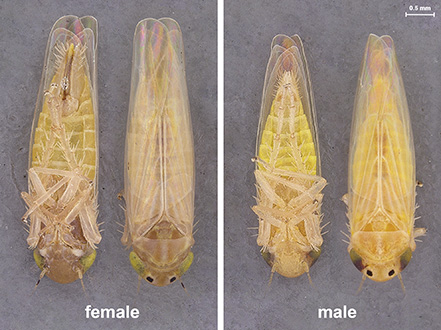
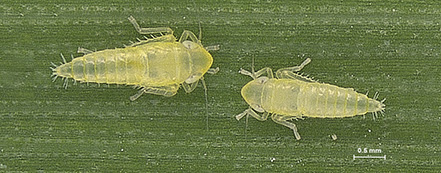
Insect description
Adult corn leaf hoppers are about 1/8 inch in length and vary from pale yellow to white. The presence of two dark spots located between the eyes is one of the main characteristics for distinguishing corn leafhoppers from other leafhoppers found in corn. Females have a distinguishing ovipositor (Figure 1). The nymphs lack wings and are like the adults and may be green or tan in color (Figure 2). The adults are highly active and can be found feeding within the corn whorl and underside of the leaves as the corn grows. Eggs are small and initially colorless and are laid into the leaf, often along the midvein.
Life cycle
The life cycle of the leafhopper is subject to significant external influences, including temperature, humidity, and the host plant. The optimal temperature for reproduction is between 77 and 86°F. Adult females lay an average of 15 eggs per day and total fecundity, or number of eggs produced, ranges from approximately 130 to 611 eggs per female. Eggs incubate for about 10 days before hatching. Nymphs will pass through five nymphal instars before becoming adults (Figure 3).
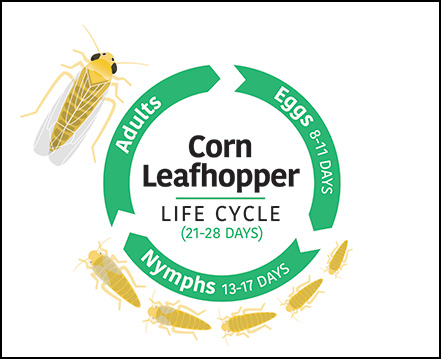
The transition from egg to adult development is highly dependent on temperature and requires about 21 to 28 days. Adult longevity varies greatly, ranging from 16 to 88 days, although up to 15 weeks has been reported.
Corn leafhoppers need a living host year-round as they do not truly overwinter. Although they will only reproduce on corn, corn leafhoppers have been noted feeding on other grass species such as gamagrass and johnsongrass. They also have been found on alfalfa, triticale, and other winter annual weeds although there is no evidence of these plants serving as feeding hosts for corn leafhoppers.
Damage to corn
Corn leaf hoppers have piercing-sucking mouthparts. Both adults and nymphs can directly damage corn by feeding on the phloem. During feeding, corn leafhoppers produce honeydew that favors the growth of black sooty mold (Figure 4). This can affect photosynthesis rates and impact yield. Female egg-laying may also cause damage to corn plants.
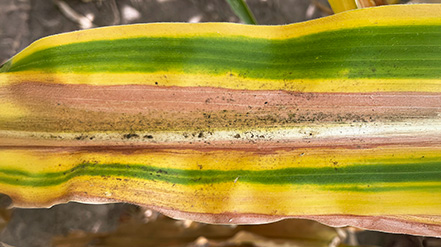
Indirect damage is the primary cause of issues and yield losses, as corn leafhoppers can transmit pathogens that are associated with corn stunt disease. This includes two bacterial and two viral pathogens. The bacterial pathogens are corn stunt spiroplasma (CSS; Spiroplasma kunkelii), and maize bushy stunt phytoplasma (MBSP; Candidatus Phytoplasma asteris). The viral pathogens are the maize rayado fino virus (MRFV) and maize striate mosaic virus (MSMV). During feeding, corn leafhoppers acquire the pathogens from an infected host plant. Then, the pathogen enters the insect’s body and multiplies for a period that can range from two to four weeks depending on the pathogen. Upon subsequent feeding, infected corn leafhoppers transmit the pathogens to healthy corn plants.
Corn stunt symptoms appear one to eight weeks after inoculation. The range and severity of corn stunt symptoms can vary and are influenced by the growth stage when infection occurred, the amount of inoculum present, the corn variety, and environmental and weather factors. Most common symptoms include yellow streaks on the base of infected leaves and yellowing or reddening of leaf tips. Additional symptoms can include shortened internodes, small ears, kernel deformation, and poor grain filling. Corn stunt can also cause wilting and plant death, which could lead to significant yield losses (Figure 5).
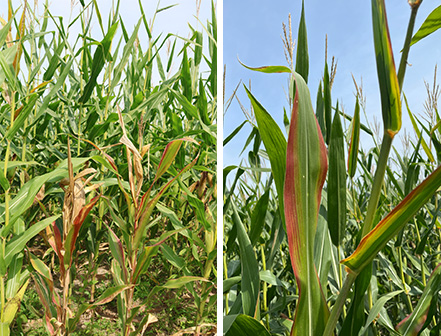
Corn stunt spiroplasma is considered the predominant pathogen associated with corn stunt disease. This bacteria was detected in Missouri in 2024 in Gentry, Knox, Boone, Pike, Lincoln, Warren, Gasconade, Osage, Morgan, Bates, Laclede, Barton and Christian counties. At this time, we have not confirmed the presence of the other corn stunt pathogens. CSS was detected in both corn leafhoppers and corn plants with disease symptoms. In addition to CSS, both MBSP and MRFV have been detected in the United States but not Maize striate mosaic virus.
Scouting and management
To reduce the risk of corn stunt transmission and to effectively manage corn leafhoppers, corn fields should be scouted early in the season. Visual scouting may not be very effective if insect numbers are low. For more accurate monitoring, consider using a battery-powered vacuum with a pantyhose stocking over the funnel or a sweep net to assess corn leafhopper presence in the field. Management of corn leafhopper is complex and should involve multiple practices aiming to reduce both the insect population and sources of disease inoculum.
Remove volunteer plants that may serve as a green bridge, or alternative host, for the corn leafhopper and as a reservoir for the corn stunt pathogens.
Plant early to reduce the risks of corn leafhopper infestations on young corn.
Consider insecticidal seed treatments that can provide control of corn leafhoppers up to the V3 growth stage and foliar insecticide applications if corn leafhoppers are present before the V8 corn growth stage.